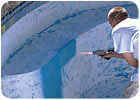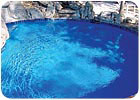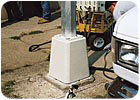Portable Plastic Powder Coatings
A new portable plastic powder coating system that does not require oven curing offers the potential to expand powder coatings into a new realm of applications.

Corrosion, rot, wear, infestations - can any building material stand up to all of these? Even the most reliable building materials have shortcomings: Steel is a durable building material, but corrosion can destroy steel structures over time. Concrete has incredible load-bearing properties and is resistant to infestations, but extreme changes in weather can cause cracks. Fortunately, materials that are valued for one reason can be modified to acquire other desired properties. Finishing surfaces with powder can improve performance and aesthetics, extend useful life, and minimize costs. No wonder powder coating has become increasingly popular.
Beginning in the 1960s, the electrostatic powder spray process (EPS) became the standard for applying organic polymer coatings. Commonly referred to as “powder coating,” the process involves applying the coating and then oven curing it, typically at 300-400°F, where melting and film formation take place. Powder coatings offer a number of benefits compared to liquid coatings. In many cases, they perform better and last longer than traditional wet paints. Most are also more resistant to chips, scratches, wear and fading, and they retain their brightness and vibrance longer. Other benefits include reduced waste, easier cleanup, good barrier protection, reclaimabilty and reusable overspray. Powder coatings are environmentally friendly, too. Because they don’t contain solvents, powder coatings don’t release volatile organic chemicals (VOCs) into the atmosphere. They are applied dry, then melted and oven cured.
But oven curing is a cumbersome and expensive process in terms of energy use, transport costs, and wait time. The need for oven curing has, therefore, kept powder coating out of certain markets.
Recently, a portable plastic powder coating system was developed that does not require oven curing. This new technology offers the potential to expand powder coatings into a new realm of applications.

Weighing just 70 lbs, the system consists of a spray gun, powder feeder and control console. With the lightweight spray gun and patented coating materials, almost any substrate can be coated in the field with a flawless, durable finish that doesn’t require oven baking. No electricity is used in the process, only propane, oxygen and compressed air, which is used to control heat transfer and the powder delivery system.
Attracted by the equipment’s energy-saving potential, New York State Energy Research and Development Authority (NYSERDA) helped to fund development of the new system. In the paper and printing industry alone - an industry that uses only moderate amounts of powder coatings - a savings of $3 million per year is forecast, along with the total elimination of toxic fumes and a tenfold reduction in waste. Conventional plants tend to be highly wasteful; the amount of powder successfully transferred to an object during coating can range from 50-95%. With the new system, up to 98% of the coating is transferred.

The core decorative and architectural range of coatings delivers weather durability, corrosion and impact resistance, plus an improved aesthetic compared to conventional powder coatings. A durable and weather-resistant glow-in-the-dark coating glows for up to eight hours with only a few minutes of exposure to natural or artificial light. Handrails, exit signs, pathways, house numbers and street signs will be easy to see at night. In addition, bicycles can be coated in part or entirely so that they are highly visible to motorists at night. Anti-microbial coatings can provide years of protection against infection-carrying bacteria, mold and mildew, while anti-slip coatings help protect people from falls. There are also anti-graffiti and anti-fouling coatings, as well as non-conductive coatings that can be used to prevent the stray voltage that sometimes emanates from light poles and manhole covers.

The new system is also becoming increasing popular for truck bed liners since it contains no methylene- bisphenyl isocyanate (MDI). The National Institute for Occupational Safety and Health has issued a health advisory warning regarding this chemical.
One of the most visually arresting uses of the new system was on a 15-year-old concrete pool. The coating on the pool was peeled in areas measuring up to 1 ft2, and cracks were releasing moisture from under the pool. The finished pool looks brand new, and the bottom of the pool feels like a vinyl liner rather than scratchy concrete. After eight months, the coating is proving highly resistant to chlorine.

The new system uses a spray gun that delivers high-quality finishes and instant curing.
Corrosion, rot, wear, infestations - can any building material stand up to all of these? Even the most reliable building materials have shortcomings: Steel is a durable building material, but corrosion can destroy steel structures over time. Concrete has incredible load-bearing properties and is resistant to infestations, but extreme changes in weather can cause cracks. Fortunately, materials that are valued for one reason can be modified to acquire other desired properties. Finishing surfaces with powder can improve performance and aesthetics, extend useful life, and minimize costs. No wonder powder coating has become increasingly popular.
Beginning in the 1960s, the electrostatic powder spray process (EPS) became the standard for applying organic polymer coatings. Commonly referred to as “powder coating,” the process involves applying the coating and then oven curing it, typically at 300-400°F, where melting and film formation take place. Powder coatings offer a number of benefits compared to liquid coatings. In many cases, they perform better and last longer than traditional wet paints. Most are also more resistant to chips, scratches, wear and fading, and they retain their brightness and vibrance longer. Other benefits include reduced waste, easier cleanup, good barrier protection, reclaimabilty and reusable overspray. Powder coatings are environmentally friendly, too. Because they don’t contain solvents, powder coatings don’t release volatile organic chemicals (VOCs) into the atmosphere. They are applied dry, then melted and oven cured.
But oven curing is a cumbersome and expensive process in terms of energy use, transport costs, and wait time. The need for oven curing has, therefore, kept powder coating out of certain markets.
Recently, a portable plastic powder coating system was developed that does not require oven curing. This new technology offers the potential to expand powder coatings into a new realm of applications.

A 15-year-old concrete pool finished with the new system. The pool looks brand new, and the bottom of the pool feels like a vinyl liner rather than scratchy concrete.
Instant Curing
For almost a century, metal has been sprayed onto surfaces by melting it in a gun and then atomizing it with compressed air to produce a fine spray. The molten spray contacts a prepared surface, and the fine droplets solidify rapidly to form a coating. Early attempts to adapt this technology for use with organic powders met with failure; the powders burned in the flame and produced discolored coatings. The new system uses a spray gun that melts powder in a flame, but, unlike previous systems, the powder is protected with a shroud of compressed air. This design better controls the temperature of the powder on melting and delivers high-quality finishes and instant curing.Weighing just 70 lbs, the system consists of a spray gun, powder feeder and control console. With the lightweight spray gun and patented coating materials, almost any substrate can be coated in the field with a flawless, durable finish that doesn’t require oven baking. No electricity is used in the process, only propane, oxygen and compressed air, which is used to control heat transfer and the powder delivery system.
Attracted by the equipment’s energy-saving potential, New York State Energy Research and Development Authority (NYSERDA) helped to fund development of the new system. In the paper and printing industry alone - an industry that uses only moderate amounts of powder coatings - a savings of $3 million per year is forecast, along with the total elimination of toxic fumes and a tenfold reduction in waste. Conventional plants tend to be highly wasteful; the amount of powder successfully transferred to an object during coating can range from 50-95%. With the new system, up to 98% of the coating is transferred.

Non-conductive coatings can be used to prevent the stray voltage that sometimes emanates from light poles.
High-Performance Finishes
A new line of mixed polymer coating materials - both thermoset and thermoplastic - has been developed to be used with the new spray system. The coating materials contain no VOCs, melt at low temperatures and require little or no preheating of the substrate. They can be applied to almost any surface (metals, plastics, glass, concrete, fiberglass, wood, ceramic and even cardboard) at thicknesses ranging from 4 mils to ¾ in. The powders adhere to most substrates without the need for priming. Surfaces need only cleaning and roughening to achieve reliable and reproducible bonding. Typical powder costs are $7 to $10/lb, with material costs ranging from $.30 to $.50/ft2. In addition to the savings realized during application, ASTM tests have shown that the coatings will last as long as traditional powder coatings, which can outlast some paints from 5 to 7:1.The core decorative and architectural range of coatings delivers weather durability, corrosion and impact resistance, plus an improved aesthetic compared to conventional powder coatings. A durable and weather-resistant glow-in-the-dark coating glows for up to eight hours with only a few minutes of exposure to natural or artificial light. Handrails, exit signs, pathways, house numbers and street signs will be easy to see at night. In addition, bicycles can be coated in part or entirely so that they are highly visible to motorists at night. Anti-microbial coatings can provide years of protection against infection-carrying bacteria, mold and mildew, while anti-slip coatings help protect people from falls. There are also anti-graffiti and anti-fouling coatings, as well as non-conductive coatings that can be used to prevent the stray voltage that sometimes emanates from light poles and manhole covers.

With the lightweight spray gun and patented coating materials, almost any substrate can be coated in the field with a flawless, durable finish that doesn't require oven baking.
Successful Applications
The new system has been used in a number of different applications. One of the biggest projects to date has been in a multi-level parking facility at an IBM building in Atlanta. The plastic sheaths on 11 miles of cable had cracked due to the expansion and contraction brought on by weather conditions. Those cables were recoated with the new system using a thermoplastic polyethylene that is durable, impact-resistant and flexible. The coating is expected to remain crack-free for a minimum of 10 years.The new system is also becoming increasing popular for truck bed liners since it contains no methylene- bisphenyl isocyanate (MDI). The National Institute for Occupational Safety and Health has issued a health advisory warning regarding this chemical.
One of the most visually arresting uses of the new system was on a 15-year-old concrete pool. The coating on the pool was peeled in areas measuring up to 1 ft2, and cracks were releasing moisture from under the pool. The finished pool looks brand new, and the bottom of the pool feels like a vinyl liner rather than scratchy concrete. After eight months, the coating is proving highly resistant to chlorine.
A Promising Future
Powder coating has long been recognized as the best in high-performance finishes. With new technology that eliminates the need for oven curing, powder coating is less expensive, easier to use and more versatile than ever.Looking for a reprint of this article?
From high-res PDFs to custom plaques, order your copy today!



